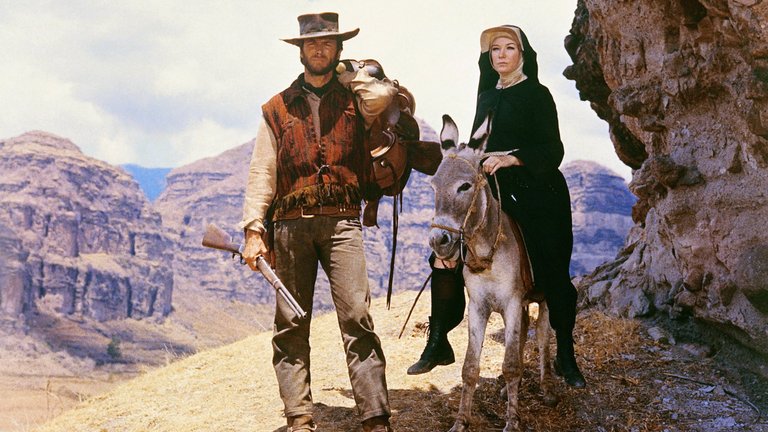Film Review: Two Mules for Sister Sara (1970)

In the pantheon of Hollywood stars who’ve become virtually synonymous with a single genre, Clint Eastwood’s name looms large over the Western. His ascent to icon status began with Sergio Leone’s Man With No Name trilogy in the mid-1960s, which redefined the spaghetti Western and etched Eastwood’s laconic, morally ambiguous gunslinger into cinematic legend. While he would drift in and out of Western roles over subsequent decades, his 1970 collaboration with director Don Siegel, Two Mules for Sister Sara, saw him lean heavily into the archetype that made him famous. The film straddles the line between homage and reinvention, blending Eastwood’s established persona with a newfound narrative playfulness—though not without stumbling into occasional tonal missteps.
Eastwood plays Hogan, a roguish US Civil War veteran turned mercenary in Mexico during the French Intervention of the 1860s. The film wastes little time establishing its central dynamic: while ambling through the desert, Hogan stumbles upon a group of bandits attempting to assault a half-naked woman (Shirley MacLaine). Dispatching the assailants with his trademark stoic efficiency, Hogan is stunned to discover the woman is Sister Sara, a Catholic nun aiding Juarista rebels against French colonial forces. Sara’s idealistic motives clash with Hogan’s mercenary pragmatism—he’s struck a deal to help the Juaristas capture a French garrison in exchange for gold—but their paths intertwine as they traverse the harsh landscape. What begins as a grudging alliance evolves into a battle of wits, with Sara’s hidden depths and Hogan’s gruff exterior masking a mutual, if begrudging, respect. The French Intervention backdrop provides a politically charged stage, though the film wisely avoids heavy-handed commentary, instead using the conflict as a catalyst for action and character friction.
The film’s genesis lies with Budd Boetticher, a veteran Western director whose original concept envisioned a lighthearted adventure set during the Mexican Revolution. Screenwriter Albert Maltz—then living in Mexico—shifted the setting to the French Intervention, a change that serendipitously allowed Two Mules to function as a loose spiritual successor to Leone’s trilogy. Eastwood’s Hogan echoes the Man With No Name: a morally flexible wanderer driven by self-interest, yet tacitly aligned with underdog forces. The connection is underscored by Ennio Morricone’s score, which, while distinct from his work on Leone’s films, employs a similarly ironic tone, blending mariachi rhythms with playful motifs that undercut the film’s occasional brutality. A cheeky nod to Eastwood’s legacy arrives when Hogan dons his iconic poncho mid-film, a winking acknowledgement of the actor’s entrenched image.
What truly distinguishes Two Mules from Leone’s oeuvre—and much of the Western canon—is its focus on a female lead. Shirley MacLaine, then a marquee name billed above Eastwood, injects Sara with a blend of wit, idealism, and unexpected grit. Maltz’s script draws deliberate parallels to The African Queen, contrasting Hogan’s rough-edged pragmatism with Sara’s veneer of pious resolve. Yet Sara is no mere Katharine Hepburn surrogate; her idealism masks a shrewd opportunism, and her habit conceals a figure far more complex than the “nun” archetype suggests. The duo’s banter crackles with unresolved sexual tension, their verbal sparring laced with double entendres. MacLaine’s performance elevates the material, ensuring Sara is neither a damsel nor a caricature but a match for Eastwood’s antihero.
The film’s greatest strength—its breezy, comedic rhythm—is nearly undone by a jarringly violent climax. For much of its runtime, Two Mules thrives on levity, particularly in its third-act twist. While modern audiences may anticipate this revelation, it would have shocked viewers in 1970, coming just years after the dissolution of the restrictive MPAA Production Code. Unfortunately, director Don Siegel undermines this narrative daring with an overblown finale. Determined to emulate Sam Peckinpah’s visceral The Wild Bunch, Siegel stages a chaotic siege featuring exploding bodies, limb-severing machetes, and a French Mitrailleuse (an early machine gun) mowing down extras. The gore feels incongruous with the preceding light comedy, as if Siegel lost confidence in the story’s quieter strengths. Only the closing scene—a sly, romantic denouement that secures Hogan’s gold and companionship—rebalances the tone, but the damage is done.
Production in Mexico proved a mixed blessing. MacLaine reportedly struggled with the local cuisine and climate, her discomfort occasionally flaring into on-set tension. Eastwood, conversely, was in his element. Fresh off collaborations with Siegel in Coogan’s Bluff (1968), their partnership here cemented a creative rapport that would later yield Dirty Harry (1971). Eastwood’s ease with Siegel’s direction is evident; he plays Hogan with a relaxed charisma, his performance a masterclass in understatement. The Mexican landscape, captured in sun-baked vistas, adds authenticity, though the film’s budgetary constraints occasionally show in cramped battle sequences.
Critics in 1970 were lukewarm, dismissing Two Mules as a derivative oddity. Yet its commercial success—and enduring cult appeal—hint at qualities overlooked at the time. While hardly a masterpiece, the film remains one of Eastwood’s more entertaining vehicles, showcasing his ability to refine, if not reinvent, his persona. MacLaine’s spirited turn ensures it avoids the misogynistic traps of lesser Westerns, and Morricone’s score remains a delight. Its flaws—chiefly Siegel’s tonal indecision—are outweighed by its charm, making it a fascinating relic of a genre in transition. For Eastwood completists, it’s essential viewing; for casual fans, a reminder of why his laconic antihero still resonates. If its violent excesses date it, its humor and heart ensure it endures—a mule, perhaps, but one that stubbornly earns its place in the caravan of Western cinema.
RATING: 7/10 (+++)
Blog in Croatian https://draxblog.com
Blog in English https://draxreview.wordpress.com/
InLeo blog https://inleo.io/@drax.leo
Hiveonboard: https://hiveonboard.com?ref=drax
InLeo: https://inleo.io/signup?referral=drax.leo
Rising Star game: https://www.risingstargame.com?referrer=drax
1Inch: https://1inch.exchange/#/r/0x83823d8CCB74F828148258BB4457642124b1328e
BTC donations: 1EWxiMiP6iiG9rger3NuUSd6HByaxQWafG
ETH donations: 0xB305F144323b99e6f8b1d66f5D7DE78B498C32A7
BCH donations: qpvxw0jax79lhmvlgcldkzpqanf03r9cjv8y6gtmk9
Posted Using INLEO